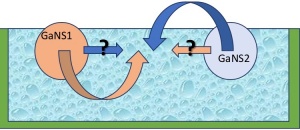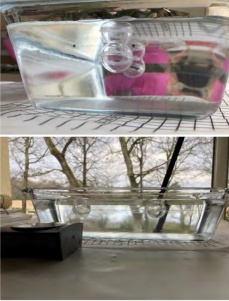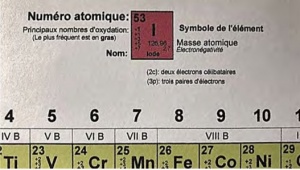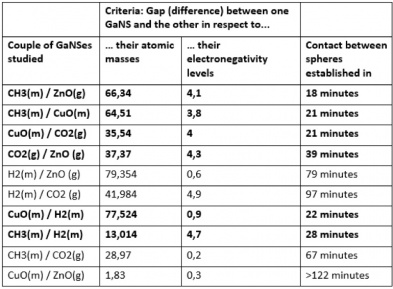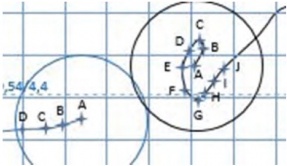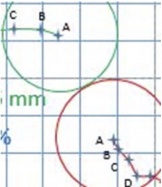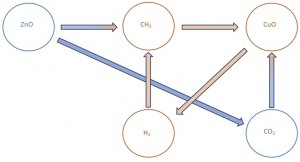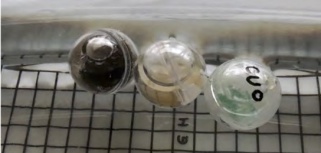Visual confirmation of a natural dynamic field flow in GaNSes
This article is part of the KF Plasma Times February 2019
Keywords: magrav, speed, travel, motion, sphere, natural dynamic flow.
Published: February 2019
Subject
The making of a GaNS is a privilege accessible to all, thanks to the generosity of Mr. Keshe and his Foundation. During my first internship, I was immediately convinced by this technology, which is now part of my daily life.
The questions on MaGrav, disc technology, GaNS, fields, with their association to the Soul are a chance to go very far to re-humanize our Planet. My background in the world of scientific research, with the desire to advance this technology in all modesty, prompts me to propose these few lines about the interaction of the best-known and most accessible fields of GaNS.
The interaction of the fields is a concrete, known and validated fact. I have investigated myself in trying to understand in more details, the interactions that exist between two GaNSes, when they are installed in two spheres close to each other; each being dedicated to one GaNS. Of course, in this situation, the fields interact. We can ask ourselves whether there is a "natural dynamic flow" between two objects (as in Fig. 1), capable of concretely generating a displacement comparable to those of two magnets that attract or repel each other - this is the purpose of the experiments I propose to you in this article.
TEST METHOD
Preparation of the tests
It is a question of making the simplest possible tests, with the following equipment:
- A large rectangular glass tray with a flat bottom filled with water,
- A series of plastic spheres with a diameter of 30 mm: each of them is filled with a GaNS (90% of the available volume),
- A grid on paper (grid every 10 mm) to follow the evolution of the spheres in the water,
- A stopwatch used to trigger the photos (every 30 seconds) and to evaluate the velocity of the sphere's movement,
- A table with an antistatic coating,
- A digital SLR camera on a stand (Fig. 2).
The glass tank was chosen with a flat bottom, with large dimensions in relation to the diameter of the test spheres, in order to eliminate edge effects (attraction of floating objects towards the walls).
The spheres were drilled at the top so that the GaNS could be injected with a syringe. The small diameter hole was filled with glue. The spheres are all similar, handled with gloves, filled with the same amount of GaNS (so that they have an identical wet surface) a few minutes before the test. They are electrostatically discharged before the test on the antistatic coating of the table.
The GaNSes used are desalinated. The sample in the jar is taken with a syringe after stirring the plasma water and the solid GaNS, so that solid GaNS particles are embedded in the spheres.
Testing strategy
CO2, CH3, ZnO, CuO and H2 GaNSes are used for the experiments. First, we test two GaNS balls at a time. The movements of the spheres are analyzed with two parameters: trajectory and time.
Photos taken every 30 seconds make it possible to visualize the movements and the time when the trajectories deviate to bring the two spheres in contact. Each pair of GaNSes tested is listed and classified according to the speed at which contact between the spheres is established.
In a second step, at the end of these tests, a classification is established to extract the most efficient in terms of attraction, and to try to define which combinations generate a "natural dynamic flow" between two objects.
In addition, two spheres filled up to 90% capacity with osmosis water are positioned in the tank, in order to validate the fact that it is the fields that puts the spheres into motion. This control group is to prove that as these balls do not carry strong fields, they should not move. A photo sequence documenting the experiment is proposed later in this article.
Distinctive criteria of each GaNS, electro negativity notion
All GaNSes have components known in classical science. They are listed in the periodic table of elements. This table is regularly updated as the specific characteristics of each element are refined. Until now, atomic mass has been the only criterion used to describe the development of the GaNS. For the tests described in this article, and given that they are in plasma condition, I propose to add electro-negativity, in order to have a more precise classification parameter, always in the context of the search for the "natural dynamic flow" between two objects.
As a reminder, the electro negativity criterion is the characteristic quantifying an atom in its ability to attract electrons during a chemical bonding. The two attributes, atomic mass and electro-negative level, are captured for each element in the periodic table, as in Fig. 4.
If we relatively compare one in relation to another, we see that the H2 GaNS and the CH3 GaNS are the "lightest" of the five; the ZnO being the "heaviest".
Table 2 lists the parameter of electronegativity, which for GaNS is added up, the same way as the atomic masses of the elements of each GaNS are added in Table 1.
We will therefore work for each test with two GaNSes, regardless of their gravitational or magnetic origin, trying to simply associate those with a large difference in their atomic mass, and/or a large difference in their electronegativity
levels.
Experimental Procedure
Each pair of GaNS was tested several times to validate the results. In order to simplify the article and not to impose all the views of all the tests (available on request), I propose you some views of a test focusing on the pair of CH3 and ZnO. The contact between the spheres in the tank in Fig. 5, took place after 18 minutes.
The tests were carried out by first selecting GaNS pairs that have large differences in value between their respective atomic masses and large differences in value of their electronegativity levels. Indeed, it is these couples that are "predisposed" to materialize the "natural dynamic flow" between the two spheres.
CASE STUDY 1 - RESULTS AND ANALYSIS
Test Results
Table 3 summarizes the results obtained.
Analysis of the test results
Before discussing the comments on all these tests, I come back to the behavior of the two spheres filled with osmosed water and positioned in the tank, in the same way as the GaNS spheres. The test took place over more than 13 hours, and as shown in Fig. 6, spheres in the control group remained immobile, and therefore support the conclusion that due to the presence of GaNS one can observe the field flow between the two spheres, as it manifests in the sphere’s physical motion.
From Table 3 we learn that:
- Two magnetic / gravitational pairs (CH3 / ZnO and CuO / CO2) are the most efficient in bringing the spheres into contact with each other (20 minutes maximum). Each GaNS of these pairs has a large difference in atomic mass and electronegativity level in respect to each other
- CH3 / ZnO: atomic masses difference = 66,34 ; electronegativity difference = 4,1
- CuO / CO2: atomic masses difference = 35,54 ; electronegativity differ ence = 4
- The other "mixed couples" magnetic/gravitational are not so effective in bringing the spheres into contact with each other - their two criteria have small deviations (the smallest being the couple CuO / ZnO with atomic masses difference = 1,83 ; electronegativity difference = 0,3; or one of the two weakest, such as case of the couple CH3/ CO2 for example, atomic masses difference = 28,97 ; electronegativity difference = 0,2).
- Gravitational/gravitational couples do not work.
- All magnetic/magnetic couples work, they allow the spheres to touch, in less than 30 minutes. It should be noted that their parameters have significant differences in values.
On the other hand, the results show that if we had to work solely with the criterion of the difference between atomic masses, it would not have been possible to discern which couples are suitable for the function and which ones are not. Indeed, to reveal the existence of a "natural dynamic flow", the criterion of electronegativity is essential, as the presented results support this conclusion.
To conclude on this first part, we only consider the GaNS couples that allow the spheres to come into contact in less than 30 minutes. These couples are: CH3/H2, CuO/H2, CH3/CuO, CuO/CO2 and ZnO/CH3.
The ZnO/CO2 couple (in blue in the table) will also be studied, as it is the only gravitational/gravitational couple that is below 40 minutes for the spheres to come in contact.
Precise analysis of the trajectories, speeds and performances of the selected GaNSes
In this second part of the study, the aim is to analyze the trajectories of the spheres in the last centimeters of the race, to evaluate their respective speeds, and to answer the following questions:
- Is there a propelling GaNS?
- If so, what is it?
- What is its relative speed?
- Which sphere will take precedence over the other?
The answers will allow us to create a diagram of how these GaNSes interact, with privileged directions of attraction.
To do this, distances are measured using the grid, and times are captured by dating the photos. These data can therefore be easily integrated, and speeds calculated. For each test, the atomic mass and electronegativity values are recalled for each GaNS pair.
CH3 15,03; 9.1 / H2 2,016; 4.4
The sphere with CH3 bends its trajectory at time D (T0 - 1'30''). The remaining distance to contact is 11.3 (CH3) + 24.3 (H2) = 35.6 mm (at that time, in a straight line, the centers are 58.8 mm apart). The distance is covered in 1'30'' – detailed trajectories of this experiment in Fig. 7.
Average speed CH3: 45.2 cm/h (distance covered: 11.3 mm)
Average speed H2: 97.2 cm/h (distance covered: 24.3 mm)
The H2 has a speed more than twice the value of the CH3. THE H2 TRAVELS TOWARDS CH3.
CuO 79,54; 5.3 / H2 2,016; 4. 4
The sphere with H2 bends its trajectory at time C (T0 - 1'). The remaining distance to contact is 8.8 (CuO) + 6.7 (H2) = 15.5 mm (at that time, in a straight line, the centers are 40.6 mm apart). It gets covered in 1' – detailed trajectories of this experiment in Fig. 8.
Average speed H2: 40.2 cm/h (distance covered: 6.7 mm). Average speed CuO: 52.8 cm/h (distance covered: 8.8 mm). CuO is faster than H2. CuO TRAVELS TOWARDS H2.
CH3 15,03; 9.1 / CuO 79,54; 5.3
The CuO sphere slightly deflects its trajectory at time D (T0 - 1'30''). The remaining distance to contact is 15.4 (CH3) + 10.55 (CuO) = 25.95 mm (at that time, in a straight line, the centers are 53.5 mm apart). The distance is covered in 1'30''– detailed trajectories of this experiment in Fig. 9..
Average speed CH3: 61.6 cm/h (distance covered: 15.4 mm)
Average speed CuO: 42.2 cm/h (distance covered: 10.55 mm);
THE CH3 TRAVELS TOWARDS CuO.
ZnO 81,37; 5 / CO2 44; 9.3
The two spheres deflect their trajectories at time C (T0 - 1'). The remaining distance to contact is 14 (ZnO) + 10.5 (CO2) = 24.5 mm (at that time, in a straight line, the centers are 42.7 mm apart). The distance is covered in 1'– detailed trajectories of this experiment in Fig. 10.
Average speed ZnO: 84 cm/h (distance covered: 14 mm)
Average speed CO2: 63 cm/h (distance covered: 10.5 mm)
ZnO TRAVELS TOWARDS CO2.
CuO 79,54; 5,3 / CO2 44; 9.3
The two spheres deflect their trajectories at time C (T0 - 1'). The remaining distance to contact is 8.6 (CuO) + 10.2 (CO2) = 18.8 mm (at that time, in a straight line, the centers are 41.8 mm apart). The distance gets covered in 1'– detailed trajectories of this experiment in Fig. 11.
Average speed CuO: 51.6 cm/h (distance covered: 8.6 mm)
Average CO2 speed: 61.2 cm/h (distance covered: 10.2 mm)
CO2 GOES TOWARDS CuO.
ZnO 81,37; 5 / CH3 15,03; 9.1
The two spheres deflect their trajectories at the time C and D (T0 - 1' and T0 - 1'30''). The remaining distance to contact is 11.8 (ZnO) + 11.4 (CH3) = 23.2 mm (at that time, in a straight line, the centers are 50.6 mm apart). The distance is covered in 1' for the ZnO and 1'30'' for the CH3 – detailed trajectories of this experiment in Fig. 12.
Average speed ZnO: 70.8 cm/h (distance covered: 11.8 mm)
Average speed CH3: 45.6 cm/h (distance covered: 11.4 mm)
ZnO GOES TOWARDS CH3.
Analysis of the test results
In summary, the attraction connections between the GaNSes is visualized in Fig. 13.
We can see that the effective combination is composed of magnetic GaNSes. This combination of H2 / CH3/ CuO allows to create a dynamic field which velocity can be estimated, as in Fig. 14.
Final conclusions
This study shows that:
- A natural dynamic flow exists between several suitably selected GaNSes,
- The electronegativity criterion is essential to sort the GaNS as part of the attraction function,
- Gravitational/gravitational GaNS couples do not attract quickly, they are not efficient in this function,
- Magnetic/magnetic GaNS couples attract quickly,
- Mixed GaNS couples operate under certain conditions (if there are large differences in atomic mass and if there are large differences in their electronegativity level).
This study contributes to the understanding of phenomena that are very well explained in the Foundation's courses, through a visual and globally quantifiable approach. Beyond these observations, it seems interesting to me to transpose these results into health device technology, MaGrav technology and disc technology.
Acknowledgements
I thank Hadile for encouraging me to publish these results.

